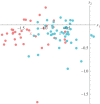Analysis of blink dynamics in patients with blepharoptosis
- PMID: 26962027
- PMCID: PMC4843668
- DOI: 10.1098/rsif.2015.0932
Analysis of blink dynamics in patients with blepharoptosis
Abstract
Owing to the rapid movements of the human upper eyelid, a high-speed camera was used to record and characterize voluntary blinking and the blink dynamics of blepharoptosis patients were compared to a control group. Twenty-six blepharoptosis patients prior to surgery and 45 control subjects were studied and the vertical height of the palpebral aperture (PA) was measured manually at 2 ms intervals during each blink cycle. The PA and blinking speed were plotted with respect to time and a predictive model was generated. The blink dynamic was analysed in closing and opening phases, and revealed a reduced speed of the initial opening phase in ptotic patients, suggesting intrinsic muscle function change in ptosis pathogenesis. The PA versus time curve for each subject was reconstructed using custom-built parameters; however, there were significant differences between the two groups. Those parameters used included the rate of closure, the delay between opening and closing, rate of initial opening, rate of slow opening (nonlinear function) and the 'switch point' between those two rates of opening. The model was tested against a new group of subjects and was able to discriminate ptosis patients from controls with 80% accuracy.
Keywords: blepharoptosis; blink dynamics; blinking; ptosis.
© 2016 The Author(s).
Figures









References
-
- Sudhakar P, Vu Q, Kosoko-Lasaki O, Palmer M. 2009. Upper eyelid ptosis revisited. Am. J. Clin. Med. 6, 5–14.
Publication types
MeSH terms
LinkOut - more resources
Full Text Sources
Other Literature Sources

